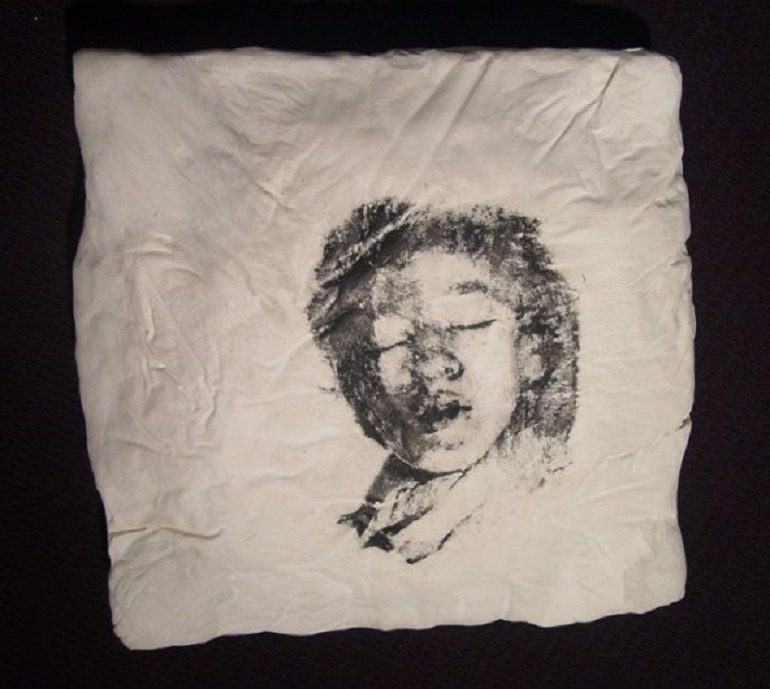ART & DESIGN
Top Management by Irina Nakhova from ‘Without a Title’. The artist uses the work to interrogate the Moscow Diary. Image courtesy of Nailya Alexander Gallery
ART REVIEW
Irina Nakhova Exposes the History of Russia in Moscow Diary
BY KAZAD

Irina Nakhova, ‘Figure Skaters,’ 2013. From ‘Without a Title’ project, Print on canvas, pastel 60 x125 inches. Image courtesy of Nailya Alexander Gallery
NEW YORK, NY—When the 56th Venice Biennale opens in 2015, Irina Nakhova will be representing Russia. She will be the first woman to have a solo exhibition in the history of the Russian Pavilion. This is a great achievement for an artist who has been striving to make a mark in her artistic career for almost 30 years. It is a well-deserved accomplishment for Nakhova, who has relentlessly toiled to prove herself in a career dominated by men.
In addition to having had over 30 solo exhibitions in North America, Europe, and Russia, Nakhova has also been contributing to the next generation of artists through teaching. In 2013, she won Russia’s prestigious Kandinsky Prize for Project of the Year, an award reserved for the best art project created by a Russian artist.
Without a Title, the project that won Nakhova the prestigious Kandinsky Prize for Project of the Year is presently on display at the Nailya Alexander Gallery in New York in an exhibition titled Irina Nakhova: Moscow Diary. This is the first time this installation is being shown in the United States. The installation consists of manipulated photographs from Nakhova’s personal and family archives. Presented in a variety of media, the archive images date from the 1920s to the present. Also featured are Skins (2009), photo sculptures Pillows (1997), and several paintings from the installation Renovation (2012).
Moscow Diary: Hidden Secrets
One of the images in this show is Top Management, 2013. This is a photograph of company executives often taken after important events. All the top executives are men: there is no woman in the picture. But this picture is not just about the top management in a company; it also has a political undertone. The picture seems a critique of a patriarchal culture where the highest political positions are reserved for men.
Top Management, 2013 is a protest of the patriarchal culture that defines not only Russia but also many other courtiers. Nakhova’s disdain for the culture that subjugates women is expressed with the defacement of the faces of the men in the photo with red paint.
Nakhova’s narrative of gender roles in Russian becomes even more visible in Figure Skaters, 2013. Unlike Top Management, 2013 that has only men, Figure Skaters, 2013 features girls and women, standing in the center of an ice rink. While this could be just a photograph of Nakhova’s family members, the insertion of this image into a gender discourse and power relationship makes it pertinent in Russia’s history. Although the faces of the girls have been scratched off, the image accentuates the notion that women can be entertainers and not part of the Top Management.
Struggle for Self-Expression
Some of the images in Irina Nakhova: Moscow Diary point to the issues of identity and the struggle for self-expression. On some of the photos, tattoos are inscribed on hidden parts of the body as if to prevent it from being seen. In Skin #4, Brooke, 2010, for instance, heads of tigers and golfers are inscribed on the back and buttocks of an individual. On another image, Skin # 10, Alison, 2010, the portrait of Jesus is inscribed on the back of a figure, pointing to the individual’s association with Christianity. There are also portraits of people etched onto pillows. They come with titles like Pillow (woman), Pillow (Man Front), and Pillow (Man Back).
A graduate of the Moscow Institute of Graphic Arts in 1978, Irina Nakhova was born in 1955. She is an installation artist and academically trained painter. Nakhova shares her home and studio between Moscow and New Jersey. A member of the Moscow Conceptual School, Nakhova works have has appeared in galleries and museums across the globe.
Irina taught art in several art institutions before going to full-time art practice. She first gained recognition when her work Rooms (1983–‐7), the first “total installation” in Russia, achieved extraordinary acclaim. There is hope that her work for the 56th Venice Biennale will bring glory to Russia. Additionally, there is hope that her work encourages female artists across the globe to make their mark in this male-dominated profession.

Irina Nakhova , Pillow (Woman), 1996. From ‘Daddy Needs to Relax’ project, Plaster, ink 23 1/2 x 21 1/2 x 8 1/2 inches. Image courtesy of Nailya Alexander Gallery
